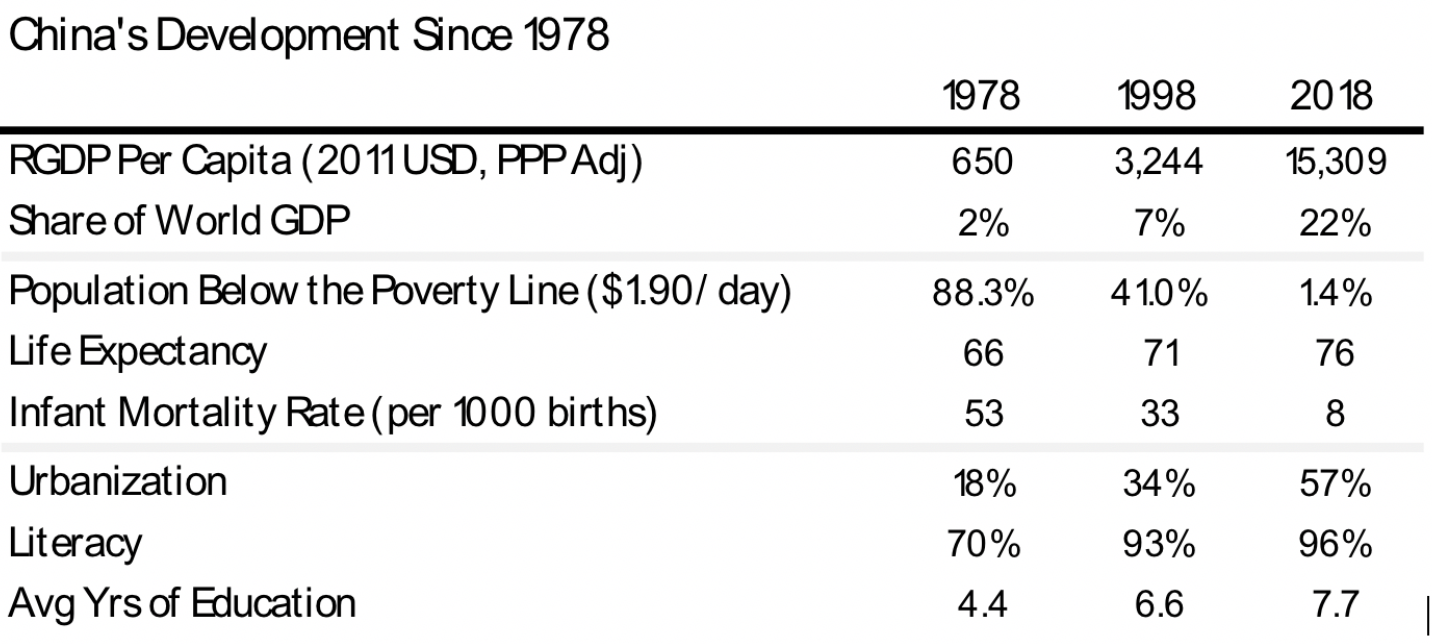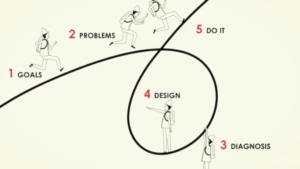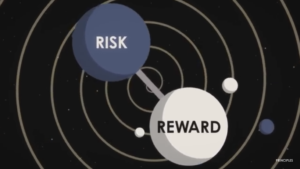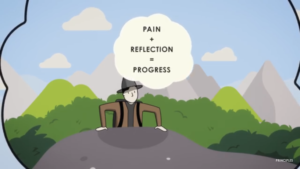Ray Dalio is arguably the most successful investor on the planet.
Over 42 years, Ray built Bridgewater into what Fortune considers the 5th most important private company in the U.S. Dalio became one the world’s 100 most influential people (Time) and one of the world’s 100 wealthiest people (Forbes). CIO Magazine called him “the Steve Jobs of investing.” Bridgewater has become the world’s largest hedge fund, managing over USD160 billion, making more money for its investors than any hedge fund in history.
Ray recently wrote an article on China to share his perspective given the current global political situation. “Results speak for themselves. To have such rates of improvements in so many areas and for so many people has made [China] the greatest economic miracle ever. Clearly whatever they did worked great.”

“The very impressive results that the Chinese leadership and the Chinese people produced came about primarily because of the powerful combination of
- China’s opening up and reforming following an extended period of isolation that led to a fast catching up (especially in the coastal regions of China) with the advanced developed world, and
- the power of the Chinese culture and it’ related ways of operating…
While Chinese culture has been evolving, it has at its most fundamental level been operating in similar ways for many hundreds or even thousands of years and the results of operating that way are knowable in an approximate way.”

“As shown, China was either the number one or number two most powerful country from 1500 to at around 1800 when it went into relative decline that continued until around 40 years ago when the opening up and reforming led to the previously described strong ascent to being the second-most powerful country in the world and on the path to being the most powerful one.”
I’ve heard interviews with him by Tim Ferriss and Tony Robbins, and Ray is as wise as they come in the business world. He has gotten to the point in his life where he feels the need to give back, and is on a mission to share the systems and strategies that have brought him success in his book PRINCIPLES. (it’s not like he needs more money).
Principles is one of those books that EVERYONE should read, and I don’t just mean those in the business world. It’s one of the top 3 books I recommend to my coaching clients. I also use it as a foundation for my full-day year planning workshop I run for my clients and their teams to set Values, Purpose, Vision, SMART Goals, Daily-Weekly-Monthly Routines.
Principles is a book about Ray’s principles, though he also mentions that everyone should come up with their own principles based on their values. I’ve written a book on my own principles, which you can download for free HERE.
Now I know that not everyone has (makes?) time to read books, so I highly recommend either watching this 30 minute Youtube animation and/or reading my summary below:
PRINCIPLES: Life & Work by RAY DALIO (Summary)
1) What you want
2) What is true
3) What you should do to achieve #1 in light of #2
LIFE PRINCIPLES
 1 Embrace reality & deal with it
1 Embrace reality & deal with it
1.1 Be a hyperrealist.
- Dreams + Reality + Determination = A Successful Life.
1.2 Truth—or, more precisely, an accurate understanding of reality —is the essential foundation for any good outcome.
1.3 Be radically open-minded and radically transparent.
1.4 Look to nature to learn how reality works.
- Don’t get hung up on your views of how things “should” be because you will miss out on learning how they really are.
- To be “good,” something must operate consistently with the laws of reality and contribute to the evolution of the whole; that is what is most rewarded.
- Evolution is the single greatest force in the universe; it is the only thing that is permanent and it drives everything.
- Evolve or die.
1.5 Evolving is life’s greatest accomplishment and its greatest reward.
- Reality is optimizing for the whole—not for you.
- Adaptation through rapid trial and error is invaluable.
- Realize that you are simultaneously everything and nothing—and decide what you want to be.
- What you will be will depend on the perspective you have.
1.6 Understand nature’s practical lessons.
- Maximize your evolution.
- Remember “no pain, no gain.”
1.7 Pain + Reflection = Progress.
1.10 If you are open-minded enough and determined, you can get virtually anything you want.
- Because it is difficult to see oneself objectively, you need to rely on the input of others and the whole body of evidence. [objective input is hard to find – coaches work well]
2 Use the 5-Step Process to Get What You Want Out of Life
2.1 Have clear goals.
- Prioritize: While you can have virtually anything you want, you can’t have everything you want.
- Never rule out a goal because you think it’s unattainable.
2.2 Identify and don’t tolerate problems.
2.3 Diagnose problems to get at their root causes.
- Focus on the “what is” before deciding “what to do about it.”
2.4 Design a plan.
- Go back before you go forward.
- Remember that there are typically many paths to achieving your goals.
- Think of your plan as being like a movie script in that you visualize who will do what through time.
- Write down your plan for everyone to see and to measure your progress against.
- Recognize that it doesn’t take a lot of time to design a good plan.
2.5 Push through to completion.
 Great planners who don’t execute their plans go nowhere. [accountability is key]
Great planners who don’t execute their plans go nowhere. [accountability is key]- Good work habits are vastly underrated. [create habits to achieve goals]
- Establish clear metrics to make certain that you are following your plan.
2.6 Remember that weaknesses don’t matter if you find solutions.
- Look at the patterns of your mistakes and identify at which step in the 5-Step Process you typically fail.
- Everyone has at least one big thing that stands in the way of their success; find yours and deal with it.
2.7 Understand your own and others’ mental maps and humility.
3 Be Radically Open-Minded
3.1 Recognize your ego and blindspot barriers.
- Your two “yous” fight to control you.
3.2 Practice radical open-mindedness.
 3.3 Appreciate the art of thoughtful disagreement.
3.3 Appreciate the art of thoughtful disagreement.
3.4 Triangulate your view with believable people who are willing to disagree.
- Plan for the worst-case scenario to make it as good as possible.
3.6 Understand how you can become radically open-minded.
- Regularly use pain as your guide toward quality reflection.
- Make being open-minded a habit.
 Meditate. [the single most important habit to cultivate]
Meditate. [the single most important habit to cultivate]- Be evidence-based and encourage others to be the same.
- Do everything in your power to help others also be open-minded.
- Know when it’s best to stop fighting and have faith in your decision-making process.
4 Understand That People Are Wired Very Differently
4.1 Understand the power that comes from knowing how you and others are wired.
4.2 Meaningful work and meaningful relationships aren’t just nice things we chose for ourselves—they are genetically programmed into us.
4.3 Understand the great brain battles and how to control them to get what “you” want.
 Realize that the conscious mind is in a battle with the subconscious mind.
Realize that the conscious mind is in a battle with the subconscious mind.- Know that the most constant struggle is between feeling and thinking.
- Choose your habits well. [your habits determine your level of success]
- Train your “lower-level you” with kindness and persistence to build the right habits.
4.4 Find out what you and others are like with personality tests.
- Shapers are people who can go from visualization to actualization
4.5 Getting the right people in the right roles in support of your goal is the key to succeeding at whatever you choose to accomplish.
- Manage yourself and orchestrate others to get what you want.
5 Learn How to Make Decisions Effectively
 5.1 The biggest threat to good decision making is harmful emotions.
5.1 The biggest threat to good decision making is harmful emotions.
5.2 One of the most important decisions you can make is who you ask questions of.
- Don’t believe everything you hear.
- Everything looks bigger up close.
- New is overvalued relative to great.
5.3 Remember the 80/20 Rule and know what the key 20 percent is.
- Be an imperfectionist.
5.4 Use the terms “above the line” and “below the line” to establish which level a conversation is on.
 5.6 The best choices are the ones that have more pros than cons, not those that don’t have any cons at all.
5.6 The best choices are the ones that have more pros than cons, not those that don’t have any cons at all.
5.7 Prioritize by weighing the value of additional information against the cost of not deciding.
5.8 Simplify!
5.9 Use principles.
WORK PRINCIPLES (so much wisdom in here it’s a long read – worth it!)
An organization is a machine consisting of two major parts: culture and people.
a. A great organization has both great people and a great culture.
b. Great people have both great character and great capabilities.
c. Great cultures bring problems and disagreements to the surface and solve them well, and they love imagining and building great things that haven’t been built before.
- Tough love is effective for achieving both great work and great relationships.
d. In order to be great, one can’t compromise the uncompromisable.
e. Make your passion and your work one and the same
- Do it with people you want to be with.
TO GET THE CULTURE RIGHT . . .
1 Trust in Radical Truth and Radical Transparency
1.2 Have integrity and demand it from others.
- Never say anything about someone that you wouldn’t say to them directly and don’t try people without accusing them to their faces.
- Don’t let loyalty to people stand in the way of truth and the well-being of the organization.
1.3 Create an environment in which everyone has the right to understand what makes sense and no one has the right to hold a critical opinion without speaking up.
1.4 Be radically transparent.
- Share the things that are hardest to share.
- Keep exceptions to radical transparency very rare.
1.5 Meaningful relationships and meaningful work are mutually reinforcing.
2 Cultivate Meaningful Work and Meaningful Relationships
2.1 Be loyal to the common mission and those who operate consistently with it.
2.2 Be crystal clear on what the deal is.
- Make sure that people understand the difference between fairness and generosity.
- Know where the line is and be on the far side of fair.
- Pay for work.
2.3 Recognize that the size of the organization can pose a threat to meaningful relationships.
2.4 Remember that most people will pretend to operate in your interest while operating in their own.
2.5 Treasure honorable people who are capable and treat you well even when you’re not looking.
3 Create a Culture in Which It Is Okay to Make Mistakes and Unacceptable Not to Learn from Them
3.1 Recognize that mistakes are a natural part of the evolutionary process.
- Fail well.
- Don’t feel bad about your mistakes or those of others. Love them!
3.2 Don’t worry about looking good—worry about achieving your goals.
- Get over “blame” and “credit” and get on with “accurate” and “inaccurate.”
3.3 Observe the patterns of mistakes to see if they are products of weaknesses.
3.4 Remember to reflect when you experience pain.
- Make sure your people are self-reflective.
- Know that nobody can see themselves objectively.
- Teach and reinforce the merits of mistake-based learning.
3.5 Know what types of mistakes are acceptable and what types are unacceptable.
- Don’t allow the people who work for you to make the unacceptable ones.
4 Get and Stay in Sync
4.1 Recognize that conflicts are essential for great relationships because they are how people determine whether their principles are aligned and resolve their differences.
- Spend lavishly on the time and energy you devote to getting in sync, because it’s the best investment you can make.
4.2 Know how to get in sync and disagree well.
- Distinguish between idle complaints and complaints meant to lead to improvement.
- Remember that every story has another side.
4.3 Be open-minded and assertive at the same time.
- Distinguish open-minded people from closed-minded people.
- Watch out for people who think it’s embarrassing not to know.
- Making suggestions and questioning are not the same as criticizing.
4.4 If it is your meeting to run, manage the conversation.
4.6 When you have alignment, cherish it.
4.7 If you find you can’t reconcile major differences—especially in values—consider whether the relationship is worth preserving.
5 Believability Weight Your Decision Making
5.2 Find the most believable people possible who disagree with you and try to understand their reasoning.
- Remember that believable opinions are most likely to come from people:
- Who have successfully accomplished the thing in question at least three times, and
- Who have great explanations of the cause-effect relationships that lead them to their conclusions.
- If someone hasn’t done something but has a theory that seems logical and can be stress-tested, then by all means test it.
- Don’t pay as much attention to people’s conclusions as to the reasoning that led them to their conclusions.
- Inexperienced people can have great ideas too, sometimes far better ones than more experienced people.
- Everyone should be up-front in expressing how confident they are in their thoughts.
5.3 Think about whether you are playing the role of a teacher, a student, or a peer and whether you should be teaching, asking questions, or debating.
5.4 Understand how people came by their opinions.
- If you ask someone a question, they will probably give you an answer, so think through to whom you should address your questions.
5.5 Disagreeing must be done efficiently.
5.6 Recognize that you don’t need to make judgments about everything.
5.7 Pay more attention to whether the decision-making system is fair than whether you get your way.
6 Recognize How to Get Beyond Disagreements
6.1 Remember: Principles can’t be ignored by mutual agreement.
- The same standards of behavior apply to everyone.
6.2 Make sure people don’t confuse the right to complain, give advice, and openly debate with the right to make decisions.
6.3 Don’t leave important conflicts unresolved.
6.4 Once a decision is made, everyone should get behind it even though individuals may still disagree.
6.6 Recognize that if the people who have the power don’t want to operate by principles, the principled way of operating will fail.
TO GET THE PEOPLE RIGHT . . .
7 Remember That the WHO Is More Important than the WHAT
7.1 Recognize that the most important decision for you to make is who you choose as your Responsible Parties.
7.2 Know that the ultimate Responsible Party will be the person who bears the consequences of what is done.
- Make sure that everyone has someone they report to.
8 Hire Right, Because the Penalties for Hiring Wrong Are Huge
8.1 Match the person to the design.
- Think through which values, abilities, and skills you are looking for (in that order).
- Make finding the right people systematic and scientific.
- Hear the click: Find the right fit between the role and the person.
- Look for people who sparkle, not just “any ol’ one of those.”
- Don’t use your pull to get someone a job.
8.2 Remember that people are built very differently and that different ways of seeing and thinking make people suitable for different jobs.
- Understand how to use and interpret personality assessments.
- Remember that people tend to pick people like themselves, so choose interviewers who can identify what you are looking for.
- Look for people who are willing to look at themselves objectively.
- Remember that people typically don’t change all that much.
8.3 Think of your teams the way that sports managers do: No one person possesses everything required to produce success, yet everyone must excel.
8.4 Pay attention to people’s track records.
- Check references.
- Recognize that performance in school doesn’t tell you much.
- While it’s best to have great conceptual thinkers, understand that great experience and a great track record also count for a lot.
- Beware of the impractical idealist.
- Don’t assume that a person who has been successful elsewhere will be successful in the job you’re giving them.
- Make sure your people have character and are capable.
8.5 Don’t hire people just to fit the first job they will do; hire people you want to share your life with.
- Look for people who have lots of great questions.
- Show candidates your warts.
- Play jazz with people with whom you are compatible but who will also challenge you.
8.6 When considering compensation, provide both stability and opportunity.
- Pay for the person, not the job.
- Have performance metrics tied at least loosely to compensation.
- Pay north of fair.
- Focus more on making the pie bigger than on exactly how to slice it so that you or anyone else gets the biggest piece.
8.7 Remember that in great partnerships, consideration and generosity are more important than money.
- Be generous and expect generosity from others.
8.8 Great people are hard to find so make sure you think about how to keep them.
9 Constantly Train, Test, Evaluate, and Sort People
9.1 Understand that you and the people you manage will go through a process of personal evolution.
- Recognize that personal evolution should be relatively rapid and a natural consequence of discovering one’s strengths and weaknesses
- Understand that training guides the process of personal evolution.
- Teach your people to fish rather than give them fish, even if that means letting them make some mistakes.
- Recognize that experience creates internalized learning that book learning can’t replace.
9.2 Provide constant feedback.
9.3 Evaluate accurately, not kindly.
9.4 Recognize that tough love is both the hardest and the most important type of love to give (because it is so rarely welcomed).
9.5 Don’t hide your observations about people.
9.6 Make the process of learning what someone is like open, evolutionary, and iterative.
9.7 Knowing how people operate and being able to judge whether that way of operating will lead to good results is more important than knowing what they did.
- If someone is doing their job poorly, consider whether it is due to inadequate learning or inadequate ability.
9.8 Continue assessing people throughout their tenure.
- When judging people, remember that you don’t have to get to the point of “beyond a shadow of a doubt.”
- It should take you no more than a year to learn what a person is like and whether they are a click for their job.
- Evaluate employees with the same rigor as you evaluate job candidates.
9.9 Train, guardrail, or remove people; don’t rehabilitate them.
9.10 Remember that the goal of a transfer is the best, highest use of the person in a way that benefits the community as a whole.
9.11 Don’t lower the bar.
TO BUILD AND EVOLVE YOUR MACHINE . . .
10 Manage as Someone Operating a Machine to Achieve a Goal
10.1 Look down on your machine and yourself within it from the higher level.
10.2 Remember that for every case you deal with, your approach should have two purposes:
1) To move you closer to your goal
2) To train and test your your people and your design
- When making rules, explain the principles behind them.
- Your policies should be natural extensions of your principles.
- There are exceptions to every rule.
10.3 Understand the differences between managing, micromanaging, and not managing.
10.4 Know what your people are like and what makes them tick, because your people are your most important resource.
10.5 Clearly assign responsibilities.
10.6 Probe deep and hard to learn what you can expect from your machine.
10.7 Think like an owner, and expect the people you work with to do the same.
10.9 Don’t treat everyone the same—treat them appropriately.
10.11 Hold yourself and your people accountable and appreciate them for holding you accountable.
10.12 Communicate the plan clearly and have clear metrics conveying whether you are progressing according to it.
10.13 Escalate when you can’t adequately handle your responsibilities and make sure that the people who work for you are proactive about doing the same.
11 Perceive and Don’t Tolerate Problems
11.1 If you’re not worried, you need to worry—and if you’re worried, you don’t need to worry.
11.2 Design and oversee a machine to perceive whether things are good enough or not good enough, or do it yourself.
11.3 Be very specific about problems; don’t start with generalizations. Avoid the anonymous “we” and “they,” because they mask personal responsibility.
11.4 Don’t be afraid to fix the difficult things.
12 Diagnose Problems to Get at Their Root Causes
12.1 To diagnose well, ask the following questions: 1. Is the outcome good or bad? 2. Who is responsible for the outcome? 3. If the outcome is bad, is the Responsible Party incapable and/or is the design bad?
12.2 Maintain an emerging synthesis by diagnosing continuously.
12.3 Keep in mind that diagnoses should produce outcomes.
12.5 Understand that diagnosis is foundational to both progress and quality relationships.
13 Design Improvements to Your Machine to Get Around Your Problems
13.2 Systemize your principles and how they will be implemented.
13.3 Remember that a good plan should resemble a movie script.
13.5 Build the organization around goals rather than tasks.
13.8 Keep your strategic vision the same while making appropriate tactical changes as circumstances dictate.
13.10 Have the clearest possible reporting lines and delineations of responsibilities.
13.11 Remember that almost everything will take more time and cost more money than you expect.
14 Do What You Set Out to Do
14.1 Work for goals that you and your organization are excited about and think about how your tasks connect to those goals.
14.2 Recognize that everyone has too much to do.
14.3 Use checklists.
14.4 Allow time for rest and renovation.
15 Use Tools and Protocols to Shape How Work Is Done
16 An idea meritocracy a single CEO is not as good as a great group of leaders
16.3 No governance system of principles, rules, and checks and balances can substitute for a great partnership.
What are your Principles?
Which of Ray’s Principles resonate most with you, and why? Identify the top 3 Principles and share them in the comments.
Do you need support to commit to them for the next year?

Then send an send me message on LinkedIn and share Your #ChinaDream with me! (I offer a certain number of free trial sessions a month to those I’d like to work with)
Sign up for a free spot at Your China Dream Virtual Summit here.






 Great planners who don’t execute their plans go nowhere. [accountability is key]
Great planners who don’t execute their plans go nowhere. [accountability is key]

